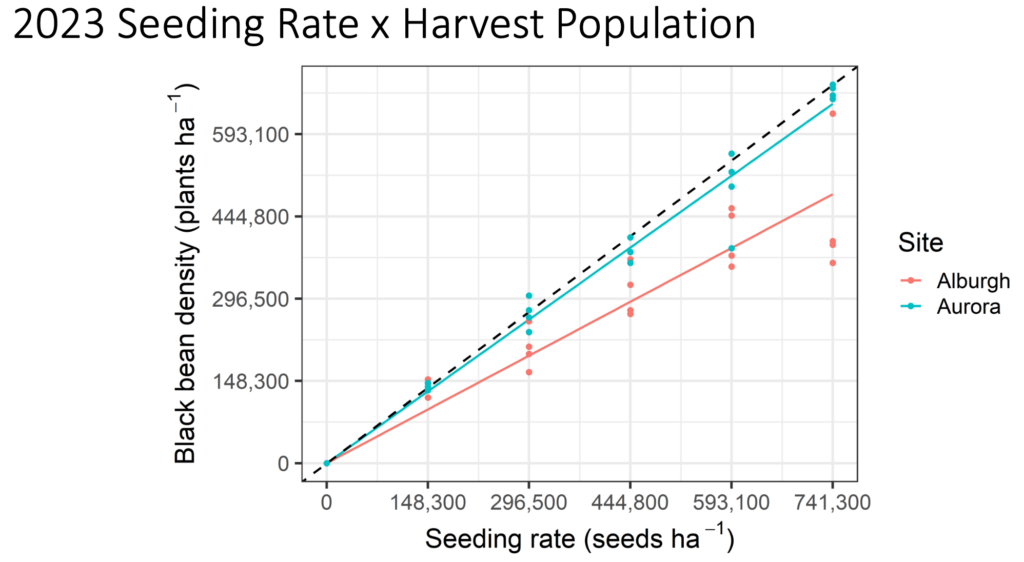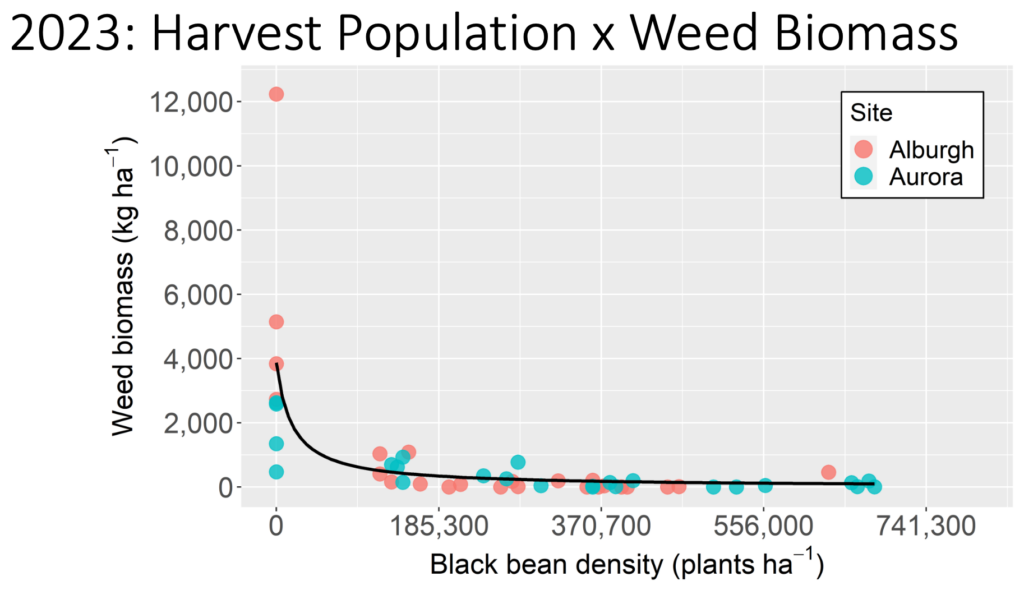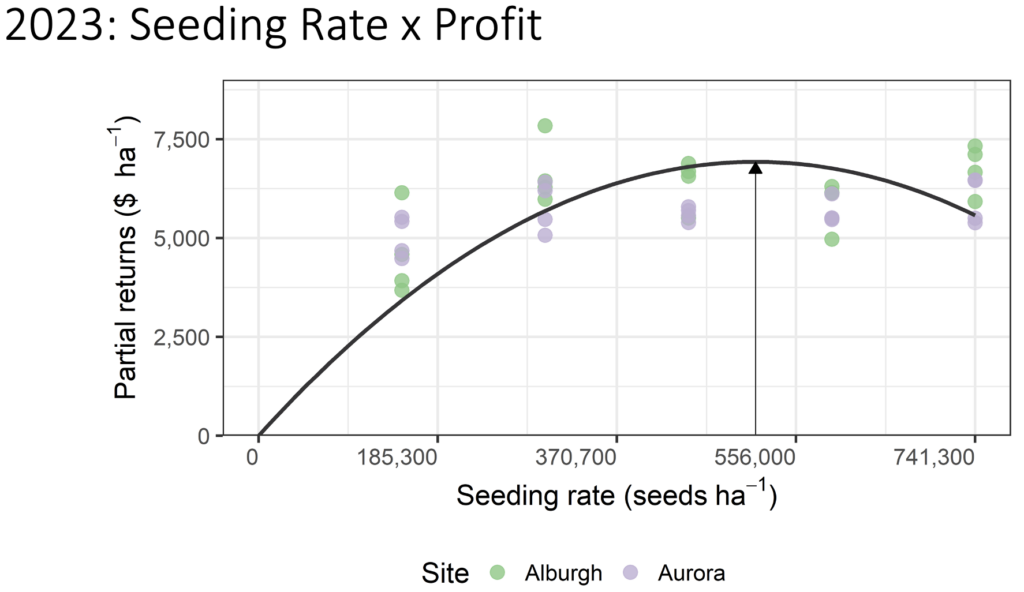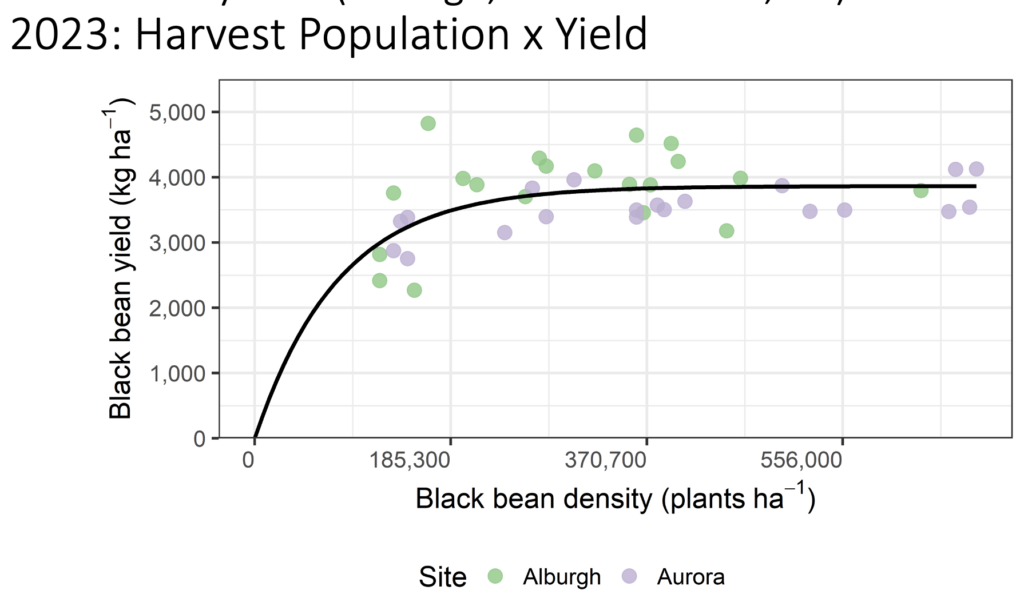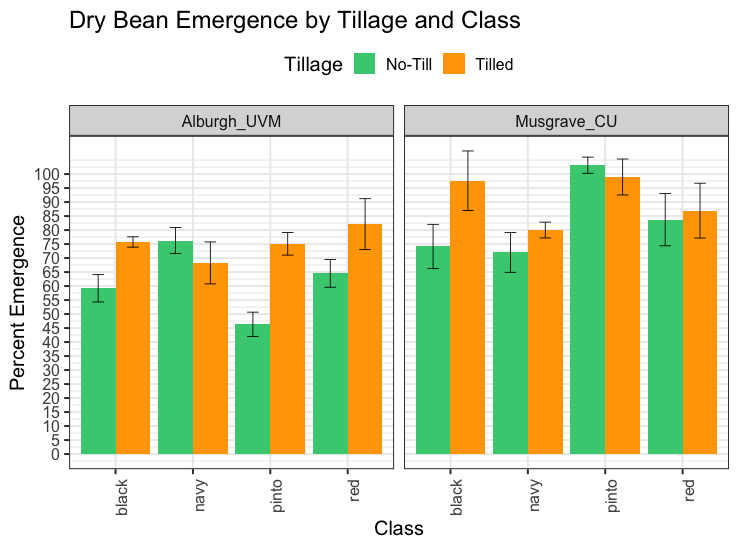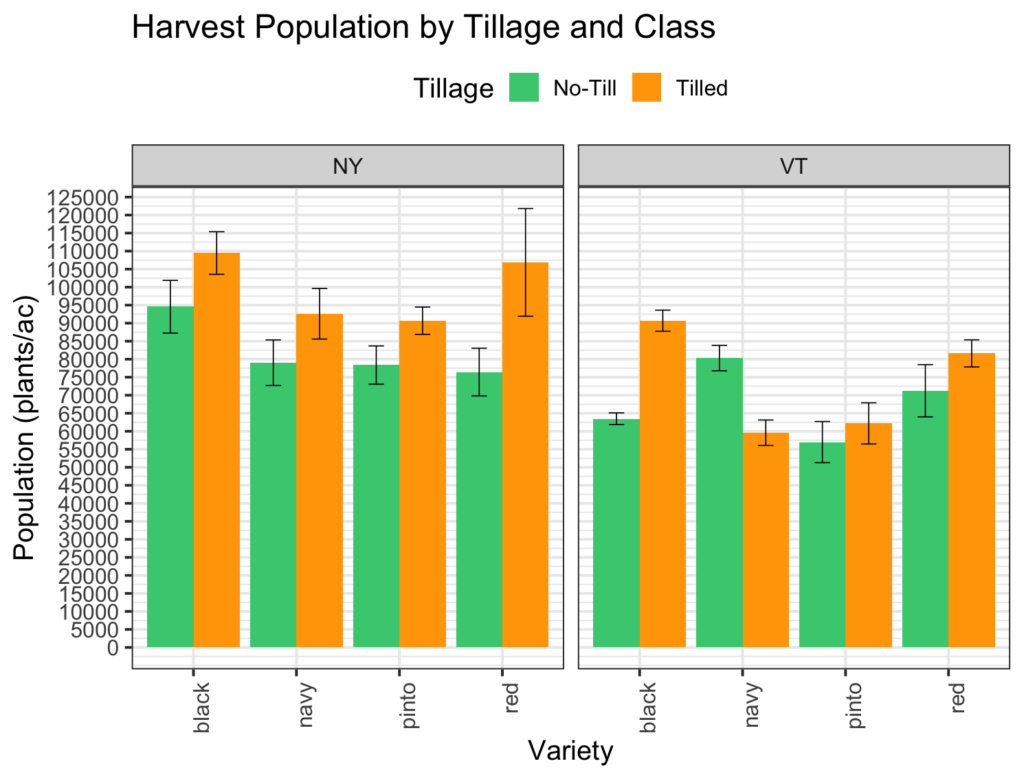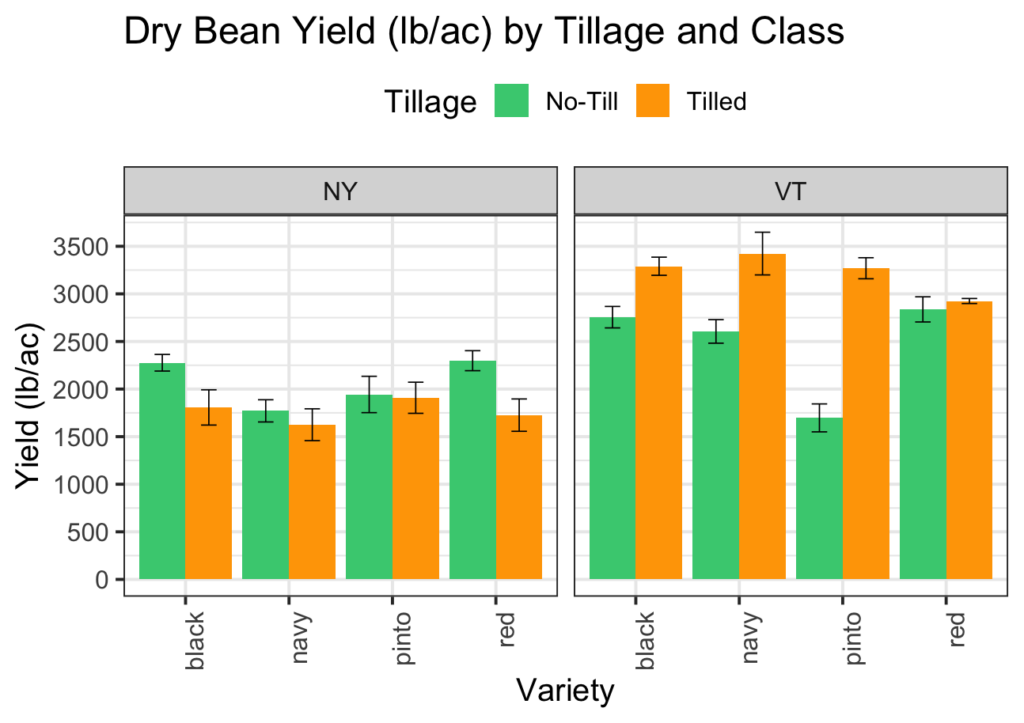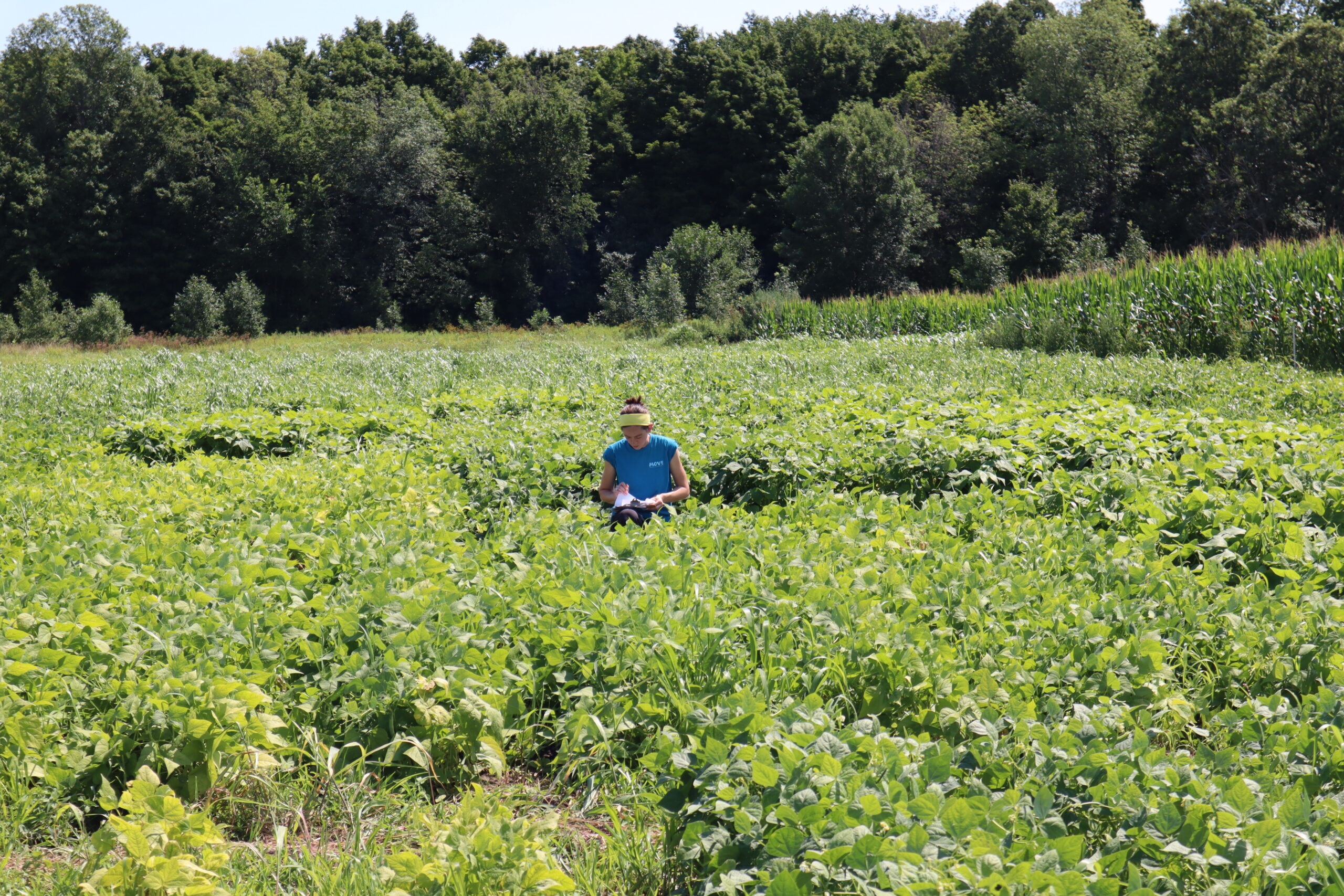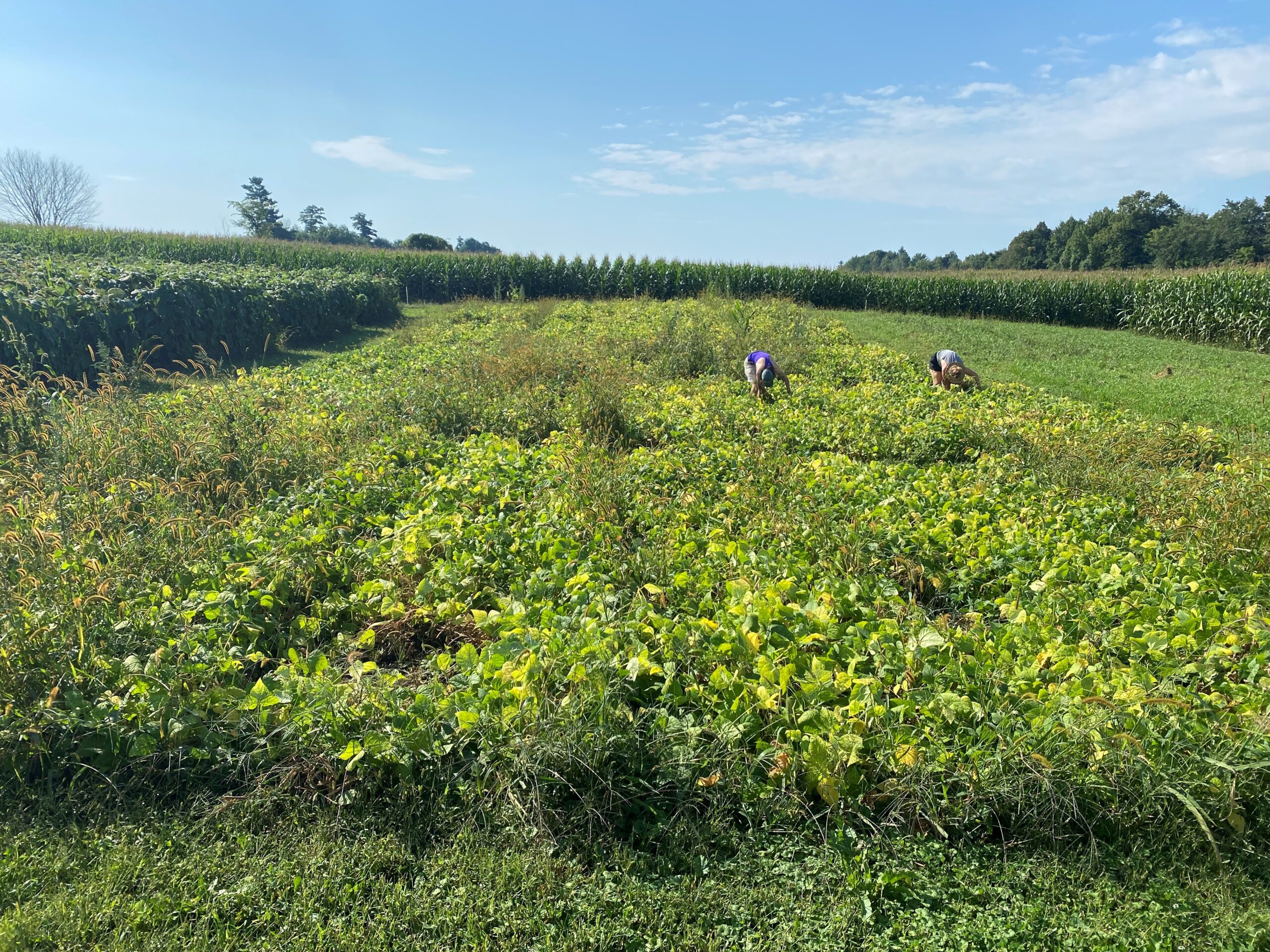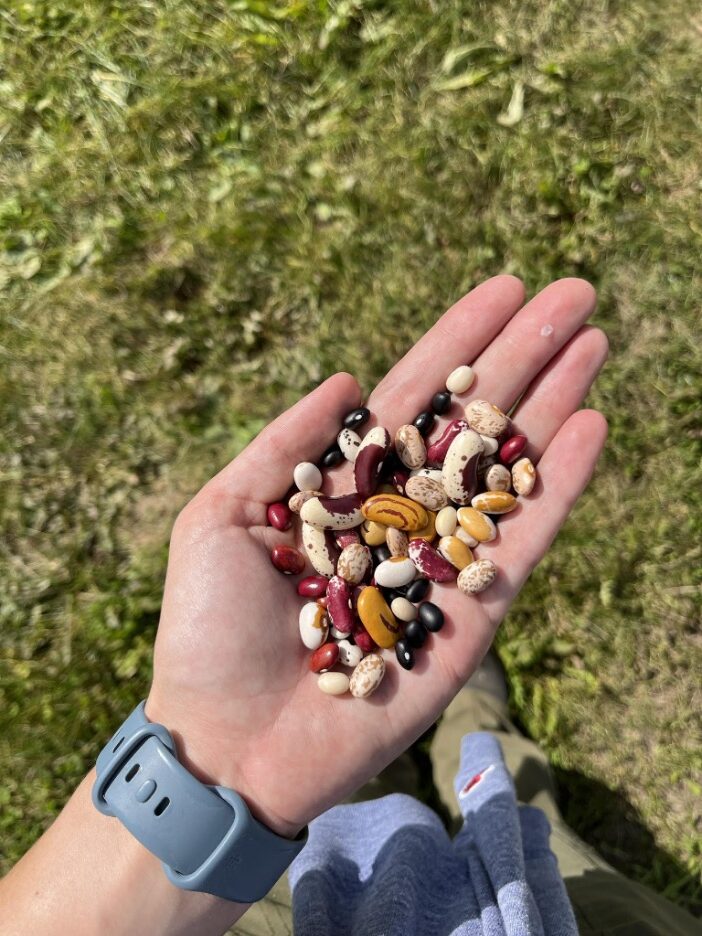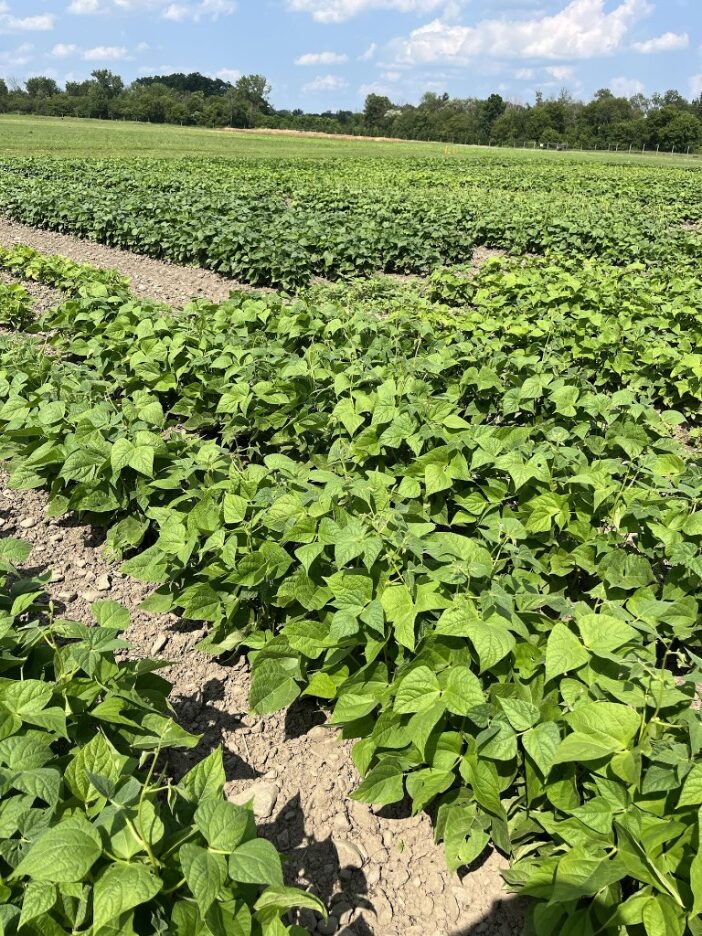Progress report for LNE22-444
Project Information
Problem and Justification:
Diverse, profitable crop rotations are essential to regenerative agriculture and food systems in the Northeast. We define “regenerative agriculture” broadly, incorporating both ecological regeneration as well as social and economic regeneration of farmer communities. With the expansion of regional small grains production, farmers need other high-value crops to improve overall farm profitability. Diverse organic crop rotations improve soil health and increase yields over time. As a food-grade legume, dry bean (Phaseolus vulgaris, also known as common bean) has potential to fill this niche and increase regional food system self-sufficiency. However, despite high demand for organic, regionally grown dry beans, regional production has not risen to meet this demand. Farmers indicate high levels of interest in adopting beans as a new crop, but often do not know where to turn for region-specific information on production and market opportunities.
Solution and Approach:
This project seeks to help build a dry bean farmer community of practice in the Northeast, facilitating knowledge exchange and sharing research-based best practices on dry bean production as part of a regenerative cropping system. Examples of regenerative practices include implementation of diverse crop rotations (particularly legume species), biological fertility and disease management, and reduced soil disturbance. Soil health is particularly crucial for production of high-quality dry beans due to issues with soilborne disease. The community of practice will help connect farmers to agronomic information, equipment resources and market opportunities that they need to successfully grow dry beans for regional markets. The burgeoning regional small-grains supply chain represents an untapped opportunity to integrate other high-value crops, and serves as an existing network of farmers, processors, and marketers with whom to engage.
Importantly, in recent years modern breeding efforts have expanded the market classes that can be direct harvested using traditional combines, lowering barriers to entry by reducing the need for specialized equipment. These market classes include navy, small red, pinto, great northern, and pink in addition to black beans. Direct harvest of dry beans facilitates regenerative production systems by reducing soil disturbance and allowing integration of cover crops and organic no-till methods. The project will leverage information from our own research as well as other bean producing regions to inform our short course and other educational resources.
This project will work closely with farmer collaborators to answer research questions and effectively share information through farmer-to-farmer learning. Our research activities will include: 1) variety trials of alternative market classes, 2) an experiment on effect of seeding rate on black bean performance in rolled-crimped rye systems, and 3) an experiment evaluating two new market classes beyond black bean in tilled vs. organic no-till systems.
25 dry bean farmers will make at least one behavior change (such as tillage reduction, cover cropping strategy or variety selection) on 300 acres. This will increase marketable yields or price received, resulting in increased gross return of $150,000 across 25 farms. Additionally, 25 farms not previously growing dry beans will begin growing them for sale on a total of 150 acres, resulting in 50 tons of Northeast-grown dry beans sold through regional market channels, increased crop rotation diversity and increased farm profitability.
This project seeks to convene farmers and researchers to build a regional base of knowledge surrounding dry bean production, cleaning, and marketing in the Northeastern United States. Consumer interest in dry beans is increasing and legumes are a crucial part of regenerative agricultural systems, but much regional knowledge around this crop has been lost and production is a shadow of its former self in most regions of the Northeast. Project leaders and our advisory team will use field research, on-farm trials and farmer-to-farmer knowledge exchange to increase the number of dry bean growers in NY and VT and increase profitability of production systems through research and deployment of best practices.
Cooperators
- (Researcher)
- (Educator)
Research
We will test the following hypotheses:
- Alternative market classes (navy, small red, pink, great northern, pinto) can perform comparably to those more commonly grown in our region (black, kidney) in both tilled and organic no-till systems.
- Above-ground cutting of upright indeterminate dry bean varieties in organic systems can yield comparably to pulling methods.
- Higher seeding rates of dry bean can improve yields and weed suppression in rolled-crimped rye systems.
- Organic no-till dry bean production improves soil health compared to tilled systems.
Research will seek to address grower interests of weed management, tillage reduction and new market classes. We will translate findings into educational resources through production guides, the Short Course and winter grower meetings. Research will occur both on research farms at Cornell and UVM as well as on cooperating grower farms to gather more accurate data and increase farmer engagement across regions.
- Effects of seeding rate in rolled-crimped rye systems and tilled systems
Weed management is the biggest challenge for organic dry bean growers. Rolled-crimped rye has shown promise in previous research to reduce weed and disease pressure in soybeans, dry beans and other crops. To date, only a single dry bean seeding rate has been trialed in this system. In comparable work with soybean, higher than typical seeding rates were found to be most profitable taking into account seed costs, and to best control weeds. Black bean seeding rates have also not been optimized for organic production systems in the Northeast, so this trial will also occur in tilled system at both research locations.
Treatment: Five seeding rates of black bean for organic no-till and tilled systems (side-by-side trials) (cv. “Zorro”)
Methods: We will assess the effect of seeding rate on yield and weed biomass in black bean in both organic no till (roll-crimped rye) and tilled systems. We will use a spatially balanced random complete block design (RCBD) with four replicates. Cereal rye will be seeded in September preceding the dry bean crop (we have already seeded this in 2021 in preparation for 2022 planting). In the tilled system, cereal rye was plowed under approximately two weeks before planting. Black bean will be planted using a no-till planter and plots will be direct harvested using a plot combine.
Data collection and analysis: We will collect data on plant population, cover crop biomass, dry bean biomass and weed biomass, yield, and seed loss from direct harvest. Data will be analyzed using mixed model ANOVA to determine a significant effect of treatments. Profitability incorporating seed costs will also be assessed.
Farmer input: This experiment reflects farmer feedback that weed control is a primary challenge in organic dry bean production as well as lack of basic information such as optimal seeding rates for our region. Growers also express high interest in organic no-till and reduction of tillage in organic field crop production.
- Effect of market class x tilled/organic no-till system
To date, only the black bean market class has been grown in an organic no-till system in a research context, though preliminary trials by the Hudson Valley Farm Hub indicate that other market classes are well suited. This experiment will compare three market classes in tilled vs. organic no-till systems to explore the relative suitability of market classes beyond black bean to an organic no-till production method. This experiment will also allow a comparison of soil health metrics between tilled vs. organic no-till dry bean systems.
Treatment: Three market classes, two tillage treatments.
Methods: We will use a split-plot random complete block design (RCBD) with four replicates. Cereal rye will be seeded in September preceding the dry bean crop (we have already seeded this in 2021 in preparation for 2022 planting). In tilled treatment areas, cereal rye will be plowed, disced and harrowed before planting. We will compare a single variety of three different market classes planted into tilled soil vs. no-till planted into rolled cereal rye in each year of the project.
Goal: Assess performance of four contrasting dry edible bean market classes in organic no-till vs. tillage-based organic production systems. A single variety of the navy, black, small red and pinto dry bean classes will be evaluated. These market classes are associated with different P. vulgaris gene pools and so may display contrasting adaptiveness to organic no-till conditions.
Varieties tested:
‘Zorro’ black bean
‘Rojo Chiquito’ small red
‘Alpena’ navy
‘Max’ pinto
Data Collection and analysis: We will collect data on plant population, crop and weed biomass, yield and seed loss from direct harvest. Soil health of tilled vs. no-till plots will be compared, assessing aggregate stability, respiration, active carbon and root disease complexes. Data will be analyzed using mixed model ANOVA to determine a significant effect of treatments.
Farmer input: This experiment reflects farmer interest in reducing tillage in their organic field crop systems, as well as interest in new market classes beyond black beans that can be direct harvested.
- Organic variety trial in two Northeastern environments
Little evaluation of alternative market classes has taken place in the Northeast in recent decades, but data from nationwide cooperative dry bean nursery trials hosted in Geneva, NY indicate that alternative market classes can achieve comparable or higher yields than black and kidney types. These alternatives include navy, small red, pink, pinto, and great northern that are valued by consumers for distinct culinary characteristics and visual appeal. Most are recent releases from modern breeding efforts so have desirable yield, growth habit and disease resistance traits. Though less “improved”, some heirlooms may also perform well, especially in short season Northeastern environments, and for smaller growers will access to higher-value markets. Entries will be chosen based on feedback from many stakeholders to identify varieties with high market demand and value as well as superior agronomic performance. Replication of the trial in the southern tier of NY and northern VT will give us important data on variation in adaptation across a range of Northeastern environments, as most of the cultivars under evaluation will have been bred in other regions.
Treatment: Market class/Variety
Methods: A spatially balanced Random Complete Block Design design (RCBD) with four replicates at NY and VT research farms; single replicates of a subset on one farm in each state (using the mother-baby trial model). Varieties will be planted into tilled soil and cultivated using inter-row cultivation until flowering.
Variety: Market Class:
| Zorro | black |
| Zenith | black |
| Eclipse | black |
| Black Tails | black |
| Merlin | navy |
| Alpena | navy |
| Blizzard | navy |
| Cowboy | pinto |
| Lariat | pinto |
| Charro | pinto |
| Max | pinto |
| Monterrey | pinto |
| Cayenne | small red |
| Rojo Chiquito | small red |
| Merlot | small red |
| Orca | specialty |
| UC Southwest Gold | specialty |
| UC Tiger's Eye | specialty |
| Gypsy Rose | specialty |
| Desert Song | specialty |
| Pencil Pod Soldier | specialty |
| Jacob's Cattle | specialty |
| Tigers Eye | specialty |
| GTS 1701 yellow eye | specialty |
| Kenearly Yellow Eye | specialty |
| UC Jacob's Cattle | specialty |
| UC Holstein | specialty |
| UC Andino | specialty |
| UC 1004 | specialty |
| UC 1005 | specialty |
Data collection and analysis: Yield, pest damage, disease, and growth habit will be recorded for each plot. A mixed model ANOVA will be used to determine significant effect of treatments on recorded traits (except for growth habit). Plots will be direct harvested with a plot combine and harvest loss will be calculated to assess appropriateness of direct harvest method with two market classes.
Farmer input: Some farmers and processors have already adopted some of these alternative market classes, in particular pinto, navy and small red, and cite high demand that is not currently being met by production. One farmer-processor noted that regional variety trials for these market classes would be useful to their operation (M. Callan personal communication). Recent advances in breeding for direct harvestable types makes these market classes well-suited to the Northeast, and these trials can reduce risk to farmers and encourage adoption of a profitable new crop or market class.
PDFs of all completed research reports:
February 2023
2022 Organic Dry Bean Variety Trial: https://www.uvm.edu/sites/default/files/Northwest-Crops-and-Soils-Program/2022%20Research%20Reports/2022_Organic_Dry_Bean_Variety_Trial_Report.pdf
March 2023
2022 Organic Black Bean Seeding Rate Trial: https://www.uvm.edu/sites/default/files/Northwest-Crops-and-Soils-Program/2022%20Research%20Reports/2022_Organic_Black_Bean_Seeding_Rate_report.pdf
April 2023
2022 VT and NY Dry Bean Variety Trial Report: 2022 Organic Dry Bean Variety Trial Summary (bpb-us-e1.wpmucdn.com)
January 2024
2023 Organic Dry Bean Variety Trial: https://legacy.drup2.uvm.edu/sites/default/files/Northwest-Crops-and-Soils-Program/2023%20Research%20Rpts/2023_Organic_Dry_Bean_Variety_Trial_Report_Final.pdf
March 2024
2023 VT Black Bean Seeding Rate Trial: https://www.uvm.edu/d10-files/documents/2024-08/2023_Organic_Black_Bean_Seeding_Rate_Trial_Report_Final.pdf
2023 VT Market Class x Tillage Trial - https://www.uvm.edu/d10-files/documents/2024-08/2023_Dry_Bean_Variety_X_Tillage_Trial.pdf
2023 Dry Bean Variety Trial - all sites:2023 Variety Trial Results
January 2025
2024 VT Market Class x Tillage Trial - https://uvmd10.drup2.uvm.edu/d10-files/documents/2025-01/2024-No-tillage-and-dry-bean-variety-trial-report.pdf
Black Bean Seeding Rate Trial -- Cultivated and Organic No-Till systems
Two years of the black bean seeding rate trial are now complete, in both no-till and tilled systems, to inform practices for current dry bean growers (predominantly growing in a tilled system) as well as expanding our understanding of no-till systems and guiding farmers that adopt this practice.
Results 2022:
The main effects of tillage and seeding rate had significant impacts on bean production. Table 3 below summarizes the significance of main effects and main effect interactions. There was a tillage treatment by seeding rate interaction for black bean emergence population and for whole bean plant biomass, illustrated in Figures 1 and 2 below. The tillage treatment by seeding rate interaction for emergence suggests that the seeding rate treatments responded differently under different tillage methods. While emergence increases with seeding rate for both treatments, dry bean emergence was higher overall when planted into tilled soil than into rolled down cereal rye. Emergence was likely suppressed by the thick layer of rye biomass. The winter rye produced approximately 6590 lbs or 3.3 tons ac-1 of dry matter. The 60,000 seeds ac-1 treatment had emergence closest to the target population for both tillage treatments and the difference between emergence and target seeding plant populations increased with seeding rate. Whole bean plant biomass, assessed at R6/R7 growth stage, was consistently lower in the no-till plots across all seeding rates. Unlike emergence population, the lowest seeding rate had the greatest whole plant biomass in the tilled plots. Biomass did increase with seeding rate in the 120,000 to 300,000 seeds ac-1 treatments, but were all lower than the 60,000 seeds ac-1 treatment. In the no-till plots, the lowest seeding rate had the least biomass, and plant biomass increased with seeding rate, although there was little difference between the 240,000 and 300,000 seeds ac-1 treatments. When planted at 60,000 seeds ac-1, dry beans were able to make up for the low populations with increased biomass under a traditional tillage system, but that was not observed in the no-till system.
Table 3. Statistical significance of tillage, seeding rate, and interactions on black
bean productivity, Alburgh, VT, 2022.
|
|
Tillage treatment |
Dry bean seeding rate |
Treatment x Seeding rate |
|
|
Emergence population |
***Ɨ |
*** |
* |
|
|
Whole plant biomass |
*** |
* |
** |
|
|
Weed biomass |
*** |
NS |
NS |
|
|
White mold |
NS§ |
NS |
NS |
|
|
Lodging |
* |
NS |
NS |
|
|
Harvest population |
NS |
*** |
NS |
|
|
Harvest moisture |
*** |
* |
NS |
|
|
Seed yield |
*** |
** |
NS |
Ɨ ***p<.0001; **.0001<p<.01; *.01<p<0.1
- NS; no significant difference between treatments.
Figure 1. Tillage treatment by seeding rate interaction for dry bean emergence populations, Alburgh, VT, 2022. Solid black line represents the target population for each seeding rate.
Figure 2. Tillage treatment by seeding rate interaction for whole bean plant biomass, Alburgh, VT, 2022.
Trial results by tillage treatment are summarized in Table 4. Dry bean emergence and whole plant biomass were both statistically greater in the tillage treatment compared to the no-till treatment. Average emergence was 142,861 plants ac-1 in the tilled plots compared to only 91,462 plants ac-1 in the no-till plots. Whole plant biomass was over 2X greater in the tilled plots (4779 lbs ac-1) than the no-till plots (2246 lbs ac-1). Weed biomass was over 40X higher in the no-till plots (441 lbs ac-1) than in the tilled plots (10.4 lbs ac-1). White mold incidence was very low in this trial, with a trial average of less than one plant in 20 with any signs of white mold, and there was no statistical difference between treatments. There was moderate lodging in this trial; the average score was 2.50. Lodging was statistically greater in the tillage treatment than in the no-till treatment. Despite the difference in emergence population, there was no significant difference in harvest population between treatments. Harvest moisture was statistically lower in the no-till plots than in the tilled plots, with moistures of 23.6% and 28.8% respectively. This is likely due to the later harvest date of the no-till plots. Both were quite high however and required additional drying prior to storage. Seed yield was statistically greater in the tilled plots (3079 lbs ac-1) than in the no-till plots (1392 lbs ac-1) despite the harvest populations being statistically similar.
Table 4. Results by tillage treatment for black bean seeding rate trial, Alburgh, VT, 2022.
|
Treatment |
Emergence population |
DM yield at R6/R7 growth stage1 |
White mold incidence2 |
Lodging3 |
Harvest population |
Harvest moisture |
DM seed yield |
||
|
Dry beans |
Weeds |
||||||||
|
|
plants ac-1 |
lbs ac-1 |
# of affected plants |
1-5 scale |
plants ac-1 |
% |
lbs ac-1 |
||
|
Tillage |
142861a† |
4779a |
10.4b |
0.03 |
2.70b |
136880 |
28.8b |
3079a |
|
|
No-till |
91462b |
2246b |
441.5a |
0.03 |
2.30a |
124937 |
23.6a |
1392b |
|
|
LSD (p=0.10)‡ |
14405 |
294.3 |
103.8 |
NS§ |
0.36 |
NS |
1.24 |
207.4 |
|
|
Trial Mean |
117162 |
3513 |
225.9 |
0.03 |
2.50 |
130909 |
26.2 |
2235 |
|
1Whole bean plant and weed biomass assessed at R6/R7 growth stage to capture peak biomass. R6/R7 growth stage characterized by oldest pods having developed seeds (other parts of plant have full-length pods with seeds almost as large as first pods; pods will be developed over whole plant).
2Incidence; Out of 20 plants, number of plants with signs of white mold.
3Lodging; visual assessment of entire plot; 1=almost all plants erect, 5=all plants down.
†Within a column, treatments marked with the same letter are statistically similar (p=0.10); top performer is in bold.
‡LSD; least significant difference at the p=0.10.
- NS; no significant difference between treatments.
Trial results by black bean seeding rate are summarized in Table 5 below. Emergence population in the highest seeding rate was statistically higher than all other treatments and decreased as seeding rate decreased. Whole plant biomass was also statistically greater in the 300,000 seeds ac-1 treatment but was not significantly different from the 240,000 or 60,000 seeds ac-1 treatments. There were no statistical differences in weed biomass, white mold incidence, or plant lodging. Harvest populations were greatest in the 300,000 seeds ac-1 treatment, but not statistically different from the 240,000 seeds ac-1 treatment. Harvest moisture was lowest in the highest seeding rate (24.7%), but not statistically different from the 240,000 or 120,000 seeds ac-1 treatments. Seed yield was the highest in the 240,000 seeds ac-1 treatment, but this was not significantly different from the 300,000 or 180,000 seeds ac-1 treatments.
Table 5. Results by seeding rate treatment for black bean seeding rate trial, Alburgh, VT, 2022.
|
Seeding rate |
Emergence population |
DM yield at R6/R7 growth stage1 |
White mold incidence2 |
Lodging3 |
Harvest population |
Harvest moisture |
DM seed yield |
||
|
Dry beans |
Weeds |
||||||||
|
seeds ac-1 |
plants ac-1 |
lbs ac-1 |
# of affected plants |
1-5 scale |
plants ac-1 |
% |
lbs ac-1 |
||
|
60,000 |
44007e |
3650ab |
297.8 |
0.04 |
2.50 |
39167d |
28.1c |
1679c |
|
|
120,000 |
77502d |
2993c |
242.3 |
0.02 |
2.00 |
86962c |
26.2abc |
2160b |
|
|
180,000 |
111850c |
3233bc |
311.4 |
0.04 |
2.75 |
143389b |
26.8bc |
2270ab |
|
|
240,000 |
161280b |
3759a |
138.3 |
0.00 |
2.63 |
181560a |
25.2ab |
2557a |
|
|
300,000 |
191170a† |
3927a |
139.8 |
0.05 |
2.63 |
203466a |
24.7a |
2510a |
|
|
LSD (p=0.10)‡ |
22777 |
465.4 |
NS§ |
NS |
NS |
34373 |
1.96 |
328.0 |
|
|
Trial Mean |
117162 |
3513 |
225.9 |
0.03 |
2.50 |
130909 |
26.2 |
2235 |
|
1Whole bean plant and weed biomass assessed at R6/R7 growth stage to capture peak biomass. R6/R7 growth stage characterized by oldest pods having developed seeds (other parts of plant have full-length pods with seeds almost as large as first pods; pods will be developed over whole plant).
2Incidence; Out of 20 plants, number of plants with signs of white mold.
3Lodging; visual assessment of entire plot; 1=almost all plants erect, 5=all plants down.
†Within a column, treatments marked with the same letter are statistically similar (p=0.10); top performer is in bold.
‡LSD; least significant difference at the p=0.10.
- NS; no significant difference between treatments.
Due to significant tillage treatment by seeding rate interactions, results by seeding rate were also analyzed separately. Results are summarized in Tables 6 and 7 below. In tilled plots, dry bean emergence was statistically highest in the highest seeding rate. While whole plant biomass was statistically highest in the lowest seeding rate, this did not lead to increased seed yield at harvest. Plants were able to grow larger at a lower seeding rate, but did not produce a greater number of seeds. Harvest population and seed yield were both statistically greater in the highest seeding rate.
In the no-till plots, black bean emergence was also greater in the higher seeding rates. There was no statistical difference in emergence between the 300,000 and 240,000 seeds ac-1 treatments. Whole plant biomass was highest in the 240,000 seeds ac-1 treatment, but not statistically different from the 300,000 seeds ac-1 treatment. Unlike the tilled plots, white mold incidence was statistically different between seeding rate treatments in no-till plots. The 120,000 and 240,000 seeds ac-1 treatments had no incidence of white mold, which was statistically lower than white mold incidence in the other three treatments. White mold incidence was quite low, and these differences may be due to plot location with the field rather than seeding rate. Harvest population and seed yield were both statistically greater in the 240,000 seeds ac-1 treatment. But harvest population in the 240,000 seeds ac-1 treatment was not statistically different from the 300,000 and 180,000 seeds ac-1 treatments. And although seed yield was highest in the 240,000 seeds ac-1 treatment, it was statistically similar to all but the lowest seeding rate.
Table 6. Results by seeding rate treatment for the tillage black bean seeding rate trial, Alburgh, VT, 2022.
|
Seeding rate |
Emergence population |
DM yield at R6/R7 growth stage1 |
White mold incidence2 |
Lodging3 |
Harvest population |
Harvest moisture |
DM seed yield |
||
|
Dry beans |
Weeds |
||||||||
|
seeds ac-1 |
plants ac-1 |
lbs ac-1 |
# of affected plants |
1-5 scale |
plants ac-1 |
% |
lbs ac-1 |
||
|
60,000 |
53108e |
5667a |
28.6 |
0.04 |
2.75 |
37174e |
29.6 |
2615b |
|
|
120,000 |
92276d |
4049c |
4.33 |
0.04 |
2.50 |
100901d |
28.9 |
3021b |
|
|
180,000 |
140737c |
4515bc |
6.96 |
0.04 |
3.00 |
144713c |
28.4 |
3211b |
|
|
240,000 |
190526b |
4604bc |
12.0 |
0.00 |
2.50 |
178568b |
28.8 |
3259b |
|
|
300,000 |
237660a† |
5061ab |
0.00 |
0.03 |
2.75 |
223044a |
28.1 |
3289a |
|
|
LSD (p=0.10)‡ |
16443 |
856.1 |
NS§ |
NS |
NS |
23433 |
NS |
293.9 |
|
|
Trial Mean |
142861 |
4779 |
10.4 |
0.03 |
2.70 |
136880 |
28.8 |
3079 |
|
1Whole bean plant and weed biomass assessed at R6/R7 growth stage to capture peak biomass. R6/R7 growth stage characterized by oldest pods having developed seeds (other parts of plant have full-length pods with seeds almost as large as first pods; pods will be developed over whole plant).
2Incidence; Out of 20 plants, number of plants with signs of white mold.
3Lodging; visual assessment of entire plot; 1=almost all plants erect, 5=all plants down.
†Within a column, treatments marked with the same letter are statistically similar (p=0.10); top performer is in bold.
‡LSD; least significant difference at the p=0.10.
- NS; no significant difference between treatments.
Table 7. Results by seeding rate treatment for the no-till black bean seeding rate trial, Alburgh, VT, 2022.
|
Seeding rate |
Emergence population |
DM yield at R6/R7 growth stage1 |
White mold incidence2 |
Lodging3 |
Harvest population |
Harvest moisture |
DM seed yield |
||
|
Dry beans |
Weeds |
||||||||
|
seeds ac-1 |
plants ac-1 |
lbs ac-1 |
# of affected plants |
1-5 scale |
plants ac-1 |
% |
lbs ac-1 |
||
|
60,000 |
34905c |
1633b |
567.0 |
0.04ab |
2.25 |
41159c |
26.6b |
743b |
|
|
120,000 |
62729bc |
1938b |
480.2 |
0.00a |
1.50 |
73024bc |
23.4ab |
1300ab |
|
|
180,000 |
82964b |
1951b |
615.9 |
0.04ab |
2.50 |
142065ab |
25.3b |
1330ab |
|
|
240,000 |
132033a |
2914a |
264.7 |
0.00a |
2.75 |
184552a |
21.5a |
1854a |
|
|
300,000 |
144680a† |
2793a |
279.5 |
0.08b |
2.50 |
183888a |
21.3a |
1731a |
|
|
LSD (p=0.10)‡ |
46947 |
461.6 |
NS§ |
0.05 |
NS |
69978 |
3.58 |
639.1 |
|
|
Trial Mean |
91462 |
2246 |
441.5 |
0.03 |
2.30 |
124937 |
23.6 |
1392 |
|
1Whole bean plant and weed biomass assessed at R6/R7 growth stage to capture peak biomass. R6/R7 growth stage characterized by oldest pods having developed seeds (other parts of plant have full-length pods with seeds almost as large as first pods; pods will be developed over whole plant).
2Incidence; Out of 20 plants, number of plants with signs of white mold
3Lodging; visual assessment of entire plot; 1=almost all plants erect, 5=all plants down.
†Within a column, treatments marked with the same letter are statistically similar (p=0.10); top performer is in bold.
‡LSD; least significant difference at the p=0.10.
- NS; no significant difference between treatments.
NY Results 2022
Within a column, treatments marked with the same letter are statistically similar (p=0.10). If no letters are displayed next to trait values, differences between treatments we not significantly different for that trait.
Aurora NY, No-Till
| Seeding Rate (Seeds/ac) | Emergence (pl/ac) | Lodging (Rating/Plot) | Yield (lb/ac, 18% moisture) | WeedBiomass (lbs/ac) | CropBiomass (lb/ac) | Harvest Population (pl/ac) | |||
| 75000 | 47818 | b | 1 | 1015 | 474.8 | 802 | b | 53131 | b |
| 150000 | 138805 | ab | 1.25 | 1230 | 554.3 | 1241 | ab | 107590 | ab |
| 225000 | 149431 | ab | 1.25 | 1433 | 270.7 | 1883 | ab | 142125 | ab |
| 300000 | 159393 | ab | 1.67 | 1312 | 595.2 | 1517 | ab | 143454 | ab |
| 375000 | 205883 | a | 1.25 | 1378 | 542.1 | 1568 | a | 177989 | a |
| Trial Mean | 140266 | 1 | 1273 | 487 | 1402 | 124858 | |||
Aurora NY, Cultivated
| Seeding Rate (Seeds/ac) | Emergence (pl/ac) | Lodging (Rating/Plot) | Yield (lb/ac, 18% moisture) | WeedBiomass (lbs/ac) | CropBiomass (lb/ac) | Harvest Population (pl/ac) | |||
| 75000 | 47818 | c | 2.75 | 2000 | 1047.4 | 2938 | 39184 | c | |
| 150000 | 110247 | bc | 2.5 | 2217 | 230.1 | 2469 | 86338 | bc | |
| 225000 | 174668 | b | 2.75 | 2097 | 139.6 | 3413 | 136812 | b | |
| 300000 | 270083 | a | 2.33 | 2278 | 178.6 | 2752 | 201012 | abc | |
| 375000 | 275617 | a | 2.75 | 2422 | 25.4 | 3381 | 217173 | a | |
| Trial Mean | 175687 | 2.62 | 2203 | 324.2 | 2991 | 136104 | |||
Geneva NY No-till (field with known white mold infestation)
| Emergence (pl/ac) | White Mold Incidence (#/20) | Lodging (Rating/Plot) | Yield (lb/ac, 18% moisture) | WeedBiomass (lbs/ac) | CropBiomass (lb/ac) | Harvest Population (pl/ac) | ||||||
| Seeding Rate (Seeds/ac) | Mean | Mean | Mean | Mean | Mean | Mean | Mean | |||||
| 75000 | 59108 | d | 0 | a | 2.5 | 1008 | b | 1461.4 | 1734 | b | 51139 | c |
| 150000 | 158729 | c | 3 | a | 1.25 | 1474 | ab | 732.0 | 2240 | b | 118881 | bc |
| 225000 | 214516 | bc | 4.25 | b | 1.75 | 1162 | ab | 714.7 | 2320 | ab | 149431 | b |
| 300000 | 255029 | ab | 8.5 | bc | 1.5 | 1628 | a | 825.5 | 2190 | ab | 229128 | a |
| 375000 | 280930 | a | 9 | c | 2 | 1581 | ab | 844.5 | 3008 | a | 221822 | a |
| Trial Mean | 193663 | 4.95 | 1.8 | 1371 | 915.6 | 2298 | 154080 |
2023 Results - New York and Vermont
DISCUSSION
In the 2021-2022 growing season, we initiated an organic black bean seeding rate trial to evaluate the impact of black bean seeding rate in two tillage systems: traditional tillage and no-till. A warm fall of 2021 resulted in very good winter rye cover crop establishment, and by the time the rye was rolled down in May 2022, it had produced over 3 tons of dry matter ac-1. The thick layer of rolled down rye did present some challenges when no-till planting black beans. Multiple passes were made with the no-till planter to cut through the dense mat of winter rye, to ensure good seed to soil contact. However, there was still delayed germination and low stand counts in the no-till plots as well as increased weed pressure, particularly within the rows, between plants. The thick layer of winter rye did suppress weeds between rows. The temperatures were cooler than average from June through September 2022 and resulted in 139 less accumulated Growing Degree Days than normal. There was 20.5 total inches of rain, 5 inches above average, during the season, but timely weed management was not an issue in the tilled plots. Weed pressure was 40X lower in the tilled plots than in the no-till plots.
Planting black beans at increasingly higher seeding rates did increase emergence populations, but the effect varied in tilled versus no-till plots. Black bean emergence was below the target population for all seeding rates in both tillage treatments, but no-till planting black beans into rolled down rye resulted in even lower emergence. At the highest seeding rate (300,000 seeds ac-1), emergence in the no-till plots was only 144,680 plants ac-1, nearly half the target population, compared to 237,660 plants ac-1 in the tilled plots. Whole plant biomass was greater overall in the tilled system, likely due to better establishment. Interestingly, the lowest seeding rate produced the most biomass in the tilled system, indicating that black beans planted at low seeding rates will produce larger plants, likely due to increased space and resource availability. The increased biomass did not result in higher seed yields, however. Overall, black bean seed yield was greater in the tilled system and increased with seeding rate. Black beans planted at 300,000 seeds ac-1 in a tilled system produced yields that were statistically greater than all other seeding rate treatments. In the no-till system, while yields were greatest when planted at 240,000 seeds ac-1, this was not statistically different from black beans planted at 120, 180, or 300,000 seeds ac-1. This suggests that while improved seed yield will be observed from doubling the seeding rate from 60,000 to 120,000 seeds ac-1, there will be little benefit to increasing black bean seeding rate above 120,000 seeds ac-1 in a no-till system.
Market class x Tillage Trial
2023 Results:
Discussion
Both New York and Vermont sites experienced a generally wet early season in 2023, with abnormally wet weather enduring throughout the 2023 season in Vermont, whereas New York site experienced abnormally dry weather in summer and fall. Across sites, relative performance of market class between no till and tillage systems was variable. At both sites, there was not a clear trend in emergence rate amongst classes when no-till and tillage systems were compared, though harvest population was generally higher in tillage systems across all market classes except for pinto. Relative yield performance was generally better in no-till systems in New York in 2023, whereas yields were higher in the tillage system for all market classes at the Vermont site in 2023. While 2024 data have not been analyzed yet, results will be useful to clarifying the mixed trends we observed in 2023.
Variety Trial -- Year 1 cultivated and no-till, Year 2 cultivated only
Organic variety trials were conducted in two Northeastern locations (Aurora, NY and Alburgh, VT) to evaluate alternative market classes to better understand variation in adaptation across a range of Northeastern environments. Little evaluation of alternative market classes has taken place in the Northeast in recent decades despite the increase in consumer demand. Consumers are interested in these alternative market classes (such as navy, small red, pink, pinto, great northern, cranberry, yellow, and heirloom/specialty) for their distinct culinary characteristics and visual appeal. Entries were chosen based on feedback from local stakeholders to identify varieties with high market demand and value as well as for agronomic performance (Table 1).
Organic variety trials were conducted in two Northeastern locations (Aurora, NY and Alburgh, VT) to evaluate alternative market classes to better understand variation in adaptation across a range of Northeastern environments. Little evaluation of alternative market classes has taken place in the Northeast in recent decades despite the increase in consumer demand. Consumers are interested in these alternative market classes (such as navy, small red, pink, pinto, great northern, cranberry, yellow, and heirloom/specialty) for their distinct culinary characteristics and visual appeal. Entries were chosen based on feedback from local stakeholders to identify varieties with high market demand and value as well as for agronomic performance (Table 1).
Table 1a. Organic dry bean varieties evaluated in Alburgh, VT, 2022.
|
Variety |
Seed Source |
Market Class |
|
Alpena |
Central Bean Co. |
Navy |
|
Black Tails |
Treasure Valley Seeds |
Black |
|
Blizzard |
Treasure Valley Seeds |
Navy |
|
California Early |
University of California, Davis |
Light Red Kidney |
|
Calypso |
GenTec Seeds LTD |
Specialty |
|
Cayenne |
Central Bean Co. |
Small Red |
|
Desert Song |
GenTec Seeds LTD |
Flor de Junio |
|
Dr Wood |
Kelley Bean Co. |
Pinto |
|
GTS 1701 |
GenTec Seeds LTD |
Yellow Eye |
|
Gypsy Rose |
GenTec Seeds LTD |
Flor de Mayo |
|
Jacob's Cattle |
GenTec Seeds LTD |
Specialty |
|
Lariat |
Treasure Valley Seeds |
Pinto |
|
Merlin |
Treasure Valley Seeds |
Navy |
|
Merlot |
Treasure Valley Seeds |
Small Red |
|
ND Palomino |
Treasure Valley Seeds |
Pinto |
|
Rojo Chiquito |
Central Bean Co. |
Small Red |
|
Soldier |
GenTec Seeds LTD |
Specialty |
|
Tiger's Eye |
GenTec Seeds LTD |
Specialty |
|
UC Andino |
University of California, Davis |
Specialty |
|
UC Southwest Gold |
University of California, Davis |
Specialty |
|
UC Tiger's Eye |
University of California, Davis |
Specialty |
|
UCD 1004 |
University of California, Davis |
Specialty |
|
UCD 1005 |
University of California, Davis |
Specialty |
|
UCD Holstein |
University of California, Davis |
Specialty |
|
UCD Jacob's Cattle |
University of California, Davis |
Specialty |
|
Zenith |
Central Bean Co. |
Black |
|
Zorro |
Treasure Valley Seeds |
Black |
Table 1b. Organic dry bean varieties evaluated in Geneva, NY, 2022.
|
Variety |
Seed Source |
Market Class |
|
Alpena |
Central Bean Co. |
Navy |
|
Black Tails |
Treasure Valley Seed |
Black |
|
Blizzard |
Treasure Valley Seed |
Navy |
|
Dr Wood |
Kelley Bean Co. |
Pinto |
|
Lariat |
Treasure Valley Seed |
Pinto |
|
Merlin |
Treasure Valley Seed |
Navy |
|
ND Palomino |
Treasure Valley Seed |
Pinto |
|
Rojo Chiquito |
Central Bean Co. |
Small Red |
|
Zenith |
Central Bean Co. |
Black |
|
Zorro |
Treasure Valley Seed |
Black |
Organic dry bean variety trials in a tilled system were conducted at both NY and VT locations. At the NY location, the variety trial was replicated in both a tilled and an organic no-till system. The organic no-till system entails planting cereal rye the previous fall, and terminating standing cereal rye at anthesis using a front-mounted I&J roller crimper at time of dry bean planting, creating a crimped cereal rye mulch that persists throughout the growing season.
The experimental design was a randomized complete block with four replications (Table 2). All soil fertility deficiencies were addressed prior to planting in accordance with state and regional soil test results. For the no-till variety trial, cereal rye (ND Gardner) was planted at the Geneva, NY location on 11-Sep 2021 at a rate of 160 lbs ac-1 (3 million pure live seeds ac-1). Prior to cover crop planting, 5-4-3 dry poultry manure was applied at a rate of 1,000 lbs ac-1. In the tilled system, primary and secondary tillage were used to prepare an adequate seedbed for dry bean planting. Dry beans were planted on 31-May 2022 at the Alburgh, VT location, and on 15-Jun 2022 at the Geneva, NY location. At planting, 25 lbs N ac-1 were applied as starter fertilizer. Dry beans were planted in 30-in rows at a depth of 1.5 to 2.5-in. Plant populations were based on seed size and market class and adjusted for germination. Small seeded varieties were planted at a target seeding rate of 110,000 pure live seeds ac-1 and large seeded varieties were planted at a target seeding rate of 85,000 pure live seeds ac-1. Weeds were managed before and after dry bean emergence according to best organic practices.
Table 2. Management details for dry bean variety trials at both trial locations, 2022.
|
Location |
Borderview Research Farm, Alburgh, VT |
Musgrave Research Farm, Aurora, NY |
|
Soil type |
Benson rocky silt loam, over shaly limestone, 8 to 15 % slopes |
Lima silt loam, 3-8% slopes |
|
Previous crop |
Spring wheat |
Cereal rye/buckwheat cover crop |
|
Tillage operations |
Pottinger TerraDisc |
Tilled trial: Moldboard plow, disc, harrow, cultimulch |
|
Plot size |
10ft x 20ft |
10ft x 45 ft |
|
Cover crop information |
N/A |
Cereal rye (var. ND Gardner) planted 11-Sep 2021 at 160 lbs ac-1 |
|
Weed management |
Tilmor Power Ox two-wheel tractor with finger weeder and hand weeding on 15, 22, 29-Jun and 20, 27-Jul 2022 |
Tilled trial: Inter-row cultivation 2x with John Deere S-tine cultivator |
|
Dry bean planting date |
31-May 2022 |
15-Jun 2022 |
|
Dry bean harvest date |
9, 15, and 21-Sep 2022 |
26-Oct 2022 |
Growth habit was assessed, and each variety was given a rating according to the growth habit classifications for dry beans, described in Table 2 below. Days to maturity was measured by recording the date at which most plants in each plot had reached maturity (growth stage R9: mature, at least 80% of the pods showing yellow and mostly ripe, only 30-40% of leaves still green). Growth habit classification for organic dry bean varieties for both locations are listed in Table 3 below. Statistical analysis was not conducted on growth habit.
Table 3. Growth habit classifications for dry beans.
|
Growth Habit Classification |
Description |
|
I |
Determinate bush |
|
IIa |
Indeterminate; completely upright with no vine or weak vine |
|
IIb |
Indeterminate; inclined upright with substantial vine |
|
III |
Indeterminate prostrate |
Table 3a. Growth habits of organic dry bean varieties evaluated in Alburgh, VT 2022.
|
Variety |
Growth habit |
100-seed weight |
|
Alpena |
IIb |
18.0 |
|
Black Tails |
IIb |
20.3 |
|
Blizzard |
IIb |
20.3 |
|
California Early |
I |
48.9 |
|
Calypso |
I |
42.3 |
|
Cayenne |
IIb |
31.0 |
|
Desert Song |
IIb |
30.9 |
|
Dr Wood |
IIb |
33.1 |
|
GTS 1701 |
III |
43.1 |
|
Gypsy Rose |
III |
27.3 |
|
Jacob's Cattle |
I |
48.9 |
|
Lariat |
III |
34.0 |
|
Merlin |
IIa |
17.3 |
|
Merlot |
III |
28.7 |
|
ND Palomino |
III |
36.3 |
|
Rojo Chiquito |
IIb |
22.5 |
|
Soldier |
IIa |
54.6 |
|
Tiger's Eye |
IIb |
50.2 |
|
UC Andino |
IIa |
36.8 |
|
UC Southwest Gold |
IIa |
27.3 |
|
UC Tiger's Eye |
IIb |
52.7 |
|
UCD 1004 |
IIa |
33.4 |
|
UCD 1005 |
I |
34.7 |
|
UCD Holstein |
IIa |
45.9 |
|
UCD Jacob's Cattle |
IIa |
N/A |
|
Zenith |
IIb |
20.9 |
|
Zorro |
IIa |
21.1 |
Table 3a. Growth habits and average 100-seed weight of organic dry bean varieties evaluated in Aurora, NY 2022.
|
Variety |
Growth habit |
100-seed weight (g) |
|
Alpena |
IIa |
14.1 |
|
Black Tails |
IIa |
18.9 |
|
Blizzard |
IIa |
18.3 |
|
Dr Wood |
IIb |
31.7 |
|
Lariat |
IIa |
31.4 |
|
Merlin |
IIa |
38.3 |
|
ND Palomino |
IIb |
16.3 |
|
Rojo Chiquito |
IIa |
22.8 |
|
Zenith |
IIa |
19.2 |
|
Zorro |
IIa |
19.9 |
Plants were harvested about 5 days after 95% of pods were brown or yellow. At the Alburgh, VT location, dry beans were harvested on 9, 15, and 21-Sep 2022 due to differences in harvest maturity between varieties. At the Geneva, NY location, all varieties were harvested on 26-Oct 2022. At harvest, pod height, lodging, and yield were assessed. Evaluations were done within two 1-m representative row lengths per plot from the center two rows. Pod height is the distance (cm) from the soil surface to the bottom of the lowest pod from 5 randomly selected plants in each of the two 1-m row lengths. Plots were given a lodging score on a 1 to 5 scale, where 1 means almost all plants are erect and 5 means all planted are down. Then all plants were removed and counted from the two 1-m row lengths and dried for 7 days at 60°C. Plants were then threshed to obtain and record seed yield. Seed moisture at time was adjusted to 14% moisture.
Results
Weather data were recorded with a Davis Instruments Vantage Pro2 weather station, equipped with a WeatherLink data logger at Borderview Research Farm in Alburgh, VT (Table X). The 2022 growing was cooler than normal with above average rainfall. There was a total of 20.53 inches of precipitation from June to September, 5 inches above average. The cooler temperatures resulted in a total of 2,106 accumulated Growing Degree Days (GDDs), 139 less than normal. The wet field conditions were challenging for timely weed management and mechanical cultivation, resulting in increased weed pressure especially later in the season.
Table X. Weather data for Alburgh, VT, 2022.
|
|
2022 |
|||
|
Alburgh, VT |
Jun |
Jul |
Aug |
Sep |
|
Average temperature (°F) |
65.3 |
71.9 |
70.5 |
60.7 |
|
Departure from normal |
-2.18 |
-0.54 |
-0.20 |
-1.99 |
|
|
||||
|
Precipitation (inches) |
8.19 |
3.00 |
4.94 |
4.40 |
|
Departure from normal |
3.93 |
-1.06 |
1.40 |
0.73 |
|
|
||||
|
Growing Degree Days (50-86°F) |
459 |
674 |
630 |
343 |
|
Departure from normal |
-64 |
-20 |
-11 |
-44 |
Based on weather data from a Davis Instruments Vantage Pro2 with WeatherLink data logger.
Historical averages are for 30 years of NOAA data (1991-2020) from Burlington, VT.
Table. Weather data for Aurora, NY, 2022.
|
2022 |
||||||
|
|
May |
June |
July |
August |
Sept |
Oct |
|
Precipitation (in) |
3.09 |
3.32 |
2.01 |
4.99 |
5.38 |
0.72 |
|
Departure from normal |
-0.09 |
-0.32 |
-1.8 |
1.52 |
1.39 |
-3.16 |
|
|
|
|
|
|
|
|
|
Average temp (F) |
60.9 |
66.4 |
71.9 |
71 |
62.3 |
53 |
|
Departure from normal |
3.3 |
-0.3 |
1 |
1.5 |
-0.6 |
1.4 |
|
|
|
|
|
|
|
|
|
GDD base 86/50 |
396 |
889 |
1551.5 |
2199 |
2599 |
2766 |
|
Departure from normal |
125 |
109 |
117.5 |
151 |
156 |
189 |
Based on weather data from Musgrave Research Station weather station and 30 yr averages from Northeast RCC CLIMOD2
The results of the organic dry bean variety trial at the Alburgh, VT location are listed below in Table 4. The top performers for each metric are in bold and any variety that was not statistically different (p=0.10) are marked with an asterisk (*). The earliest maturing variety was UC Southwest Gold, reaching R9 stage 85 days after planting. This was not statistically different from five other varieties, Cayenne, Desert Song, GTS 1701, California Early, and Merlot. The varieties Dr Wood, Soldier, UC Andino, UCD Holstein, and UCD Jacobs Cattle took the longest to mature, reaching R9 stage 113 days after planting, almost a month after the earliest maturing variety. At harvest, UCD Holstein had the highest population, 86,301 plants ac-1, and that was not significantly different from eleven dry bean varieties. Dry bean yield at 14% moisture ranged from 569 lbs ac-1 (Calypso) to 3,451 lbs ac-1 (Blizzard). The top performer was not statistically different from nineteen dry bean varieties. The trial average score for lodging at harvest was 2.28, and the variety Desert Song had the most lodging with a score of 4.50, indicating that nearly all the plants were completely horizontal. This was not statistically different from nine other varieties. There was an average pod height of 3.30-cm. Zenith had the greatest pod height, 7.80-cm, and was not statistically different from eleven varieties.
Table 4. Organic dry bean variety trial performance summary, Alburgh, VT, 2022.
|
Variety |
Days to maturity |
Harvest population |
Lodging |
Pod height |
Yield at 14% moisture |
|
|
DAP1 |
plants ac-1 |
1-5 rating2 |
cm |
lbs ac-1 |
||
|
Alpena |
97 |
58419* |
1.75 |
3.33* |
3081* |
|
|
Black Tails |
97 |
73024* |
2.75* |
6.83* |
3205* |
|
|
Blizzard |
99 |
62402* |
2.00 |
6.43* |
3451 |
|
|
California Early |
94* |
57091 |
1.50 |
3.20* |
2471* |
|
|
Calypso |
105 |
17260 |
1.75 |
0.25 |
569 |
|
|
Cayenne |
90* |
47134 |
1.50 |
4.98* |
2462* |
|
|
Desert Song |
95* |
48461 |
4.50 |
0.70 |
2171* |
|
|
Dr Wood |
113 |
53108 |
3.25* |
3.23* |
2601* |
|
|
GTS 1701 |
89* |
61075* |
3.50* |
1.80 |
1987 |
|
|
Gypsy Rose |
99 |
65058* |
4.25* |
1.40 |
1964 |
|
|
Jacobs Cattle |
100 |
36512 |
3.75* |
0.93 |
1068 |
|
|
Lariat |
96 |
55100 |
2.50* |
7.08* |
2897* |
|
|
Merlin |
102 |
73024* |
2.00 |
4.75* |
3016* |
|
|
Merlot |
93* |
63730* |
3.00* |
5.50* |
2322* |
|
|
ND Palomino |
97 |
40495 |
2.00 |
2.48 |
2699* |
|
|
Rojo Chiquito |
109 |
71032* |
2.75* |
5.23* |
2686* |
|
|
Soldier |
113 |
59747* |
3.00* |
1.15 |
2308* |
|
|
Tigers Eye |
109 |
43151 |
2.00 |
1.30 |
626 |
|
|
UC Andino |
113 |
37575 |
1.64 |
1.45 |
2527* |
|
|
UC Southwest Gold |
85 |
45142 |
1.75 |
1.18 |
1978 |
|
|
UC Tigers Eye |
105 |
53108 |
1.50 |
1.35 |
1842 |
|
|
UCD 1004 |
107 |
54234 |
1.13 |
0.99 |
3057* |
|
|
UCD 1005 |
106 |
39186 |
1.47 |
1.12 |
2245* |
|
|
UCD Holstein |
113 |
86301 |
1.00 |
2.40 |
2390* |
|
|
UCD Jacobs Cattle |
113 |
75016* |
1.75 |
2.95 |
2903* |
|
|
Zenith |
100 |
57755 |
1.00 |
7.80 |
2809* |
|
|
Zorro |
109 |
68377* |
2.00 |
6.75* |
2632* |
|
|
LSD (p=0.10) |
|
|
|
|
|
|
|
Trial Mean |
101 |
56198 |
2.28 |
3.30 |
2371 |
1 Days after planting
2 Lodging scale- 1= almost all plants erect, 2= either all plants leaning slightly or a few plants down, 3= either all plants leaning moderately (45°angle) or 25-50% down, 4= either all plants leaning considerably or 50-80% down, 5= all plants down
Table. Organic dry bean variety trial performance summary, Aurora, NY, 2022 – Tilled Trial.
|
Variety |
Market Class |
Days to Maturity |
Harvest Population |
Lodge Score |
Pod Height |
Yield (14% moisture) |
|||||
|
DAP |
plants ac-1 |
1-5 rating |
cm |
lbs ac-1 |
|||||||
|
Alpena |
navy |
113 |
bc |
39348 |
abc |
1.75 |
cd |
1.13 |
bcd |
2989 |
ab |
|
Black Tails |
black |
115 |
bc |
42683 |
ab |
1.75 |
cd |
1.95 |
bc |
2535 |
abc |
|
Blizzard |
navy |
119 |
bc |
34680 |
abc |
2.5 |
bc |
2.45 |
b |
2387 |
bc |
|
Dr Wood |
pinto |
121 |
bc |
37348 |
abc |
3.25 |
ab |
4.23 |
a |
3758 |
a |
|
Lariat |
pinto |
109 |
c |
27344 |
bc |
3.25 |
ab |
2.00 |
bc |
3529 |
ab |
|
Merlin |
navy |
118 |
bc |
41349 |
ab |
1.25 |
d |
2.05 |
bc |
3053 |
ab |
|
ND Palomino |
pinto |
136 |
a |
21675 |
c |
4 |
a |
0.03 |
d |
1741 |
c |
|
Rojo Chiquito |
small red |
126 |
ab |
43017 |
ab |
2.5 |
bc |
1.55 |
bcd |
2591 |
abc |
|
Zenith |
black |
116 |
bc |
28011 |
bc |
1.25 |
d |
0.78 |
cd |
2716 |
abc |
|
Zorro |
black |
125 |
ab |
47018 |
a |
3 |
ab |
0.83 |
bcd |
2449 |
bc |
|
LSD (p=.10) |
|
|
|
|
|
|
|||||
|
Trial Mean: |
|
120 |
36247 |
2.45 |
1.70 |
2775 |
|||||
Table. Organic dry bean variety trial performance summary, Aurora, NY, 2022 – Organic No-Till Trial.
|
Variety |
Market Class |
Days to Maturity |
Harvest Population |
Lodge Score |
Pod Height (cm) |
Yield (14% moisture) |
|||||
|
DAP |
1-5 rating |
cm |
|
lbs ac-1 |
plants ac-1 |
||||||
|
Alpena |
navy |
120 |
cd |
22342 |
abcd |
1 |
b |
1.53 |
abc |
1084 |
bc |
|
Black Tails |
black |
124 |
bcd |
25010 |
abcd |
1 |
b |
3.00 |
a |
1672 |
ab |
|
Blizzard |
navy |
123 |
bcd |
19674 |
bcd |
1 |
b |
2.93 |
ab |
1274 |
bc |
|
Dr Wood |
pinto |
128 |
abcd |
22008 |
abcd |
2.75 |
a |
1.15 |
c |
2155 |
a |
|
Lariat |
pinto |
116 |
d |
20008 |
abcd |
2.75 |
a |
2.37 |
abc |
1684 |
ab |
|
Merlin |
navy |
135 |
ab |
16006 |
cd |
1.25 |
b |
2.68 |
abc |
1159 |
bc |
|
ND Palomino |
pinto |
139 |
a |
13005 |
d |
2.75 |
a |
1.30 |
bc |
803 |
c |
|
Rojo Chiquito |
small red |
128 |
abcd |
32012 |
ab |
1.02 |
b |
2.25 |
abc |
1640 |
ab |
|
Zenith |
black |
126 |
abcd |
27677 |
abc |
1 |
b |
1.73 |
abc |
1409 |
bc |
|
Zorro |
black |
131 |
abc |
32012 |
a |
1 |
b |
2.25 |
abc |
1558 |
ab |
|
LSD (p=.10) |
|
|
|
|
|
|
|||||
|
Trial Mean: |
|
127 |
22975.385 |
1.55 |
2 |
1444 |
|||||
Discussion
At the Alburgh, VT location despite cool, wet conditions during the growing season, many of the dry bean varieties included performed well. Days to maturity ranged from 85 to 113 day after planting. The cool, wet conditions made timely weed management challenging especially as the dry beans approached harvest maturity. Weed pressure was not measured in this trial but did result in some yield loss for varieties that had poor emergence. For example, Calypso (specialty/heirloom), a late maturing variety, had significant weed pressure resulting in low yields. Top yielding varieties ranged from early to late maturing varieties indicating that varieties with a range of maturities can achieve good seed yields in northern Vermont. The lowest yielding varieties were all specialty/heirloom varieties. The top yielding varieties were navy and black bean varieties, but specialty varieties like UCD 1004 and UCD Jacobs Cattle had comparable yields.
At the Aurora, NY location periods of cool weather in June may have resulted in poor emergence and lower plant populations in the organic no-till trial. Drier than normal June and July followed by above average precipitation in August and September caused many varieties, particularly in the tilled trial, to put on new vegetative growth and flowers later in the season, causing excessive vining and uneven maturity. As a result, harvest was delayed until late October due to delayed dry down in many plots. Despite these anomalies, yields were overall high in the tilled trial. Yields were significantly lower in the organic no-till trial, in part due to much lower plant populations for most varieties. Weed pressure was low in the tilled trial and moderate to high in the organic no-till plots.
Alburgh VT Trials (2023):
Freeville NY Trials (2023)
Education
Engagement
Participants have been recruited through the Northern Grain Growers Conference (average 125 attendees), the UVM Northwest Crops and Soils e-list, OGRAIN, the NEOGRAIN listserv, and Extension Educator contacts. Individuals will ‘opt-in’ to the project contact list. This list of bean growers (currently 80 individuals) will be targeted for virtual content and invited to events. An estimated 200 farmers will participate in at least one project activity yearly.
Learning
Project Listserv: Will be used for project outreach, resource sharing and farmer-to-farmer troubleshooting during the season, facilitated by project leaders. We expect this list to grow from 80 to 150 farmers. (Loria)
Online Dry Bean Short Course: Engage new farmers (or existing) in an intensive five-part webinar series covering basics of dry bean production, processing, and marketing. This course will use the Extension online course platform and include recorded video and results from research trials, resource guides, as well as live content provided by project leaders and experienced farmers. Participants will receive a record-keeping booklet upon completion. Participants will access continuing education via Virtual Coffee Club and field days during the season. An estimated 30 farmers will participate yearly. (Winter 2023 and 2024). (Darby and Loria).
Bean Cleaning/Processing Workshop: 1 bean processor/farmer in each state will host a workshop in winter months to educate farmers on equipment needed to produce high quality bean products necessary for high-value markets. Farmers will also learn about opportunities for custom processing and selling to processors wholesale. Estimated attendance of 50 farmers. (Winter 2023 and 2024). (Bossen and Gianforte).
Grower-led research: 2 collaborating farmers will plant on-farm research plots. These trials will provide a site for twilight meetings, serve as case studies to share with other farmers, and facilitate farmer-to-farmer learning. Trial reports will be shared at winter farmer meetings and in the Short Course (Summer 2023 and 2024; also Summer 2022 in NY) (Seth Johnson, Andrew Casner, Peter Martens).
Virtual Coffee Club: Biweekly virtual mentoring session targeted to short course participants, all welcome; farmers bring questions for group troubleshooting, timely management decisions are reviewed, research updates shared. (Darby and Loria)
Field Days/Twilight meetings: Cornell Aurora Farm Field Days (average attendees = 100), 1 farmer-to-farmer twilight meeting per year in each state at collaborating farms. Estimated twilight meeting attendance of 40 farmers. This will allow regional relationship building and resource sharing around bean production and processing, hosted by well-known and respected farmers. (Seth Johnson, Jeff Arnold, Peter Martens, Luke Gianforte).
Winter Farmer Meetings: Results and resources will be presented annually at the Northern Grain Growers Conference (average attendees = 125, NOFA-NY Winter Conference (average attendees = 1100), New York Certified Organic (NYCO) meetings, and the Hudson Valley Grain School (average attendees = 100). (Ryan, Darby, Loria).
Dry Bean Grower Library: Will build on guides already developed by PI Darby’s NESARE Partnership Grants – three guides will include 1) production and equipment information including a profitability analysis, 3) processing and storage information/processor directory and 3) variety performance information. 250 people will access the production guides in print or online format. (Darby)
Evaluation (Darby and Loria)
- Baseline survey administered to gauge current knowledge and practices of the participants prior to short course (see draft verification tool). (winter 2023 and 2024)
- Quick-poll surveys to verify knowledge gained on the topics presented during the course. (early 2023 and 2024)
- Follow-up survey will also measure impacts of the end of participants’ first growing season. (fall 2023 and 2024).
Participants will be surveyed following each conference or workshop participation event to further assess knowledge gained and any changes to production they have adopted (fall of 2023 and 2024).
Participants in the coffee club will be surveyed at the end of each season to assess knowledge gained and any changes to production they have adopted (Fall of 2023 and 2024).
In year 3 (end of 2024), a more thorough evaluation will be administered to assess improvements in knowledge and behavioral changes as a result of the project (see draft verification tool). Survey tools will be accessible through an online platform or as paper-based surveys.
Supportive Guidance and Tools
We will inform all program participants of the goals of the project and provide them with the tools and resources to verify progress towards the performance target. Once enrolled in the short course, growers will gain access to the online platform that will provide continued access to course materials throughout the life of the project (and beyond). Virtual coffee club will be open to all program participants and allow regular engagement with project personnel as well as experienced mentor farmers.
Milestones
- 80 farmers sign up for the project e-list after learning about the project through the 2023 Northern Grain Growers Conference and online outreach (January 2023)
Status: Complete
Accomplishments:
- 130 individuals signed up for 2023 webinar series, after publicizing the event through our existing dry bean e-list (80 members) and UVM and Cornell Extension and social media networks.
- 152 Individuals are now subscribed to the NE dry bean listserv.
- Social media: Our research trial updates, reports, and events got shared through our social media channels
-
- Facebook – https://www.facebook.com/uvmcropsoil 1.5K followers as of 12/19/23
- Instagram – https://www.instagram.com/uvm_nwcropsoil/ 1,105 followers as of 12/19/23
- Twitter – https://twitter.com/UVMExtcropsoil 310 followers, as of 12/19/23
- YouTube – https://www.youtube.com/user/cropsoilsvteam - 3.79K subscribers and 235 videos as of 12/19/23
4. The information also gets shared with the NGGA listserv and in their newsletter which has 555 members.
- Two farmer collaborators host on-farm research in project years 2 and 3 (also year 1 in New York) including a subset of variety trials, harvest method trials, and rolled-crimped rye trials. They will learn how alternative varieties produce on their farms, document new practices as well as outcomes from the trial, and incorporate successful varieties into future production (end 2024)
Status: Complete
Accomplishments:
In 2022 one farmer collaborator, the Hudson Valley Farm Hub, hosted a strip trial of the black bean seeding rate trial in organic no-till in 2022. While statistically signficantly different results were not determined, the trial was reported has useful to the farm for thinking about their seeding rate practices.
In 2023 a farmer collaborator, Peter and Klaas Martens, planted a demonstration trial of no-till planted black beans into harvested barley stubble in the first week of July. Both 15" and 30" row spacings were trialed and some 30" row sections were also run through with the Ryan Lab's interrow mower to manage weeds. Yields were roughly half of full-season tilled plots, which would be comparable profitability to a buckwheat crop planted in the same rotation slot.
In 2023 and 2024, a New York farmer collaborator, Stuart Farr planted demonstration trials of organic no till black bean, planted into both roll-crimped cereal rye and a cereal rye - crimson clover intercrop. Yields were excellent in 2023 and good in 2024. A home-built inter-row mower was used to manage weeds in between dry bean rows as needed. The trial host felt that building soil health ahead of the cereal rye cover crop was beneficial to achieving high levels of cover crop biomass to suppress weeds and favorable soil tilth for successful dry bean establishment and vigor.
- 80 farmers and 10 Extension Educators attend a summer twilight meeting or field day and learn about promising dry bean varieties, weed management and harvest methods at a cooperating farm or research station. Farmers leverage information into behavior change for the current or future production year. Occurs in years 1-3. (end 2024).
Status: Complete
Accomplishments:
-
7/27/23: UVM Annual Crops & Soils Field Day (181 attendees) where we highlighted the research trials. Plots were labeled with treatment or variety information for attendees to read. Printed copies of dry bean research reports were made available as well.
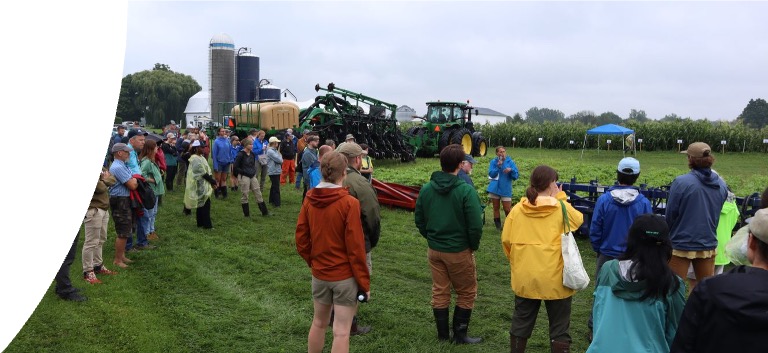
- 8/15/23: Reduced Tillage Field Day at Martens Farm / Seneca Grain and Bean in Penn Yan, NY. 160 attendees heard presentations on reduced tillage research, toured no-till dry bean and soybean demonstration plots, and toured the grain and bean cleaning facility. Printed research reports and SARE published books were available for free to attendees.
- .
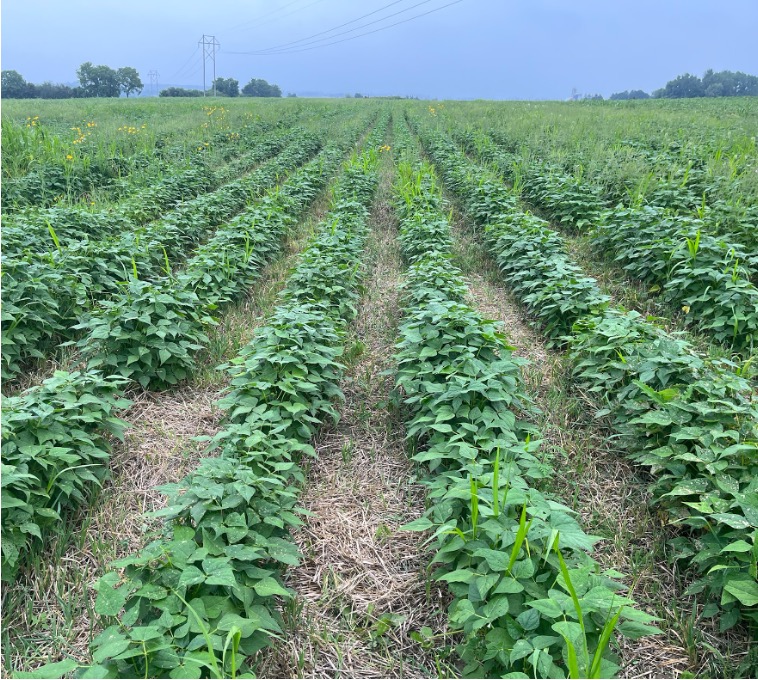
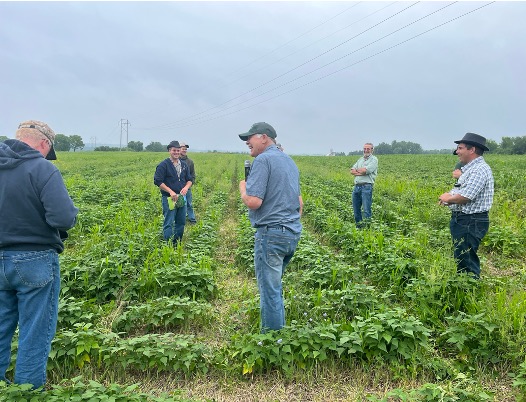
- 2024 Northwest Crops and Soils Field Day - 176 attendees attended the field day, including touring the variety trial, market class x tillage and black bean interrow mowing trials, with past year results shared on a poster and via handouts.
- 2024 Musgrave Research Farm Field Day - 140 attendees toured the dry bean market class x tillage and black bean interrow mowing trials, and learned about adaptive weed management strategies for organic no-till production systems. A public sensory evaluation of dry bean variety trial entries was conducted to get consumer feedback on sensory quality of heirloom and improved heirloom varieties.
- Freeville Farm Field Day - 58 attendees toured the variety trial and learned about specialty dry bean varieties.
Do to the format of the field days, data on farmer behavior change was not collected but surveying of behavior change occurred via other avenues.
- 100 farmers attend winter presentations or conferences and learn about dry bean production, processing and marketing. Farmers use new knowledge to improve management decisions in following production year. Occurs Winter of years 1, 2 and 3 (end 2024).
Status: In progress. (preoject-end presentations will take place in March 2025)
Accomplishments:
- Presented at Hudson Valley Grain School (Brewster, NY) to 150 attendees about dry bean production, niche marketing and our SARE project, and advertised the upcoming webinar. Two farmers personally reported a change in plans for the season after the session; written feedback from participants has not yet been received from meeting organizers. Significant interest in dry beans in the Hudson Valley, with a new potential processor having been started recently (Milestone Mill). Connections also made with GrowNYC wholesale purchaser interested in being connected with Northeast farmers, and Farm-to-School Extension specialists interested in collaborating on school purchasing of dry beans.
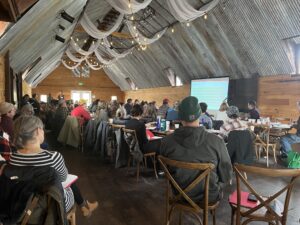
- "Diversifying with Dry Beans" presentation at OGRAIN February 2024 conference in Madison WI, estimated 250 attendees at entire conference, approximately 65 attendees in dry bean session.
- Will present project-end findings at the Northern Grain Growers Conference in March 2025.
- 100 farmers attend a winter workshop and learn about dry bean processing and marketing, hosted by a cooperating farmer-processor. Farmers use information gained to improve bean cleaning operations on their own farms or access services of processors, as well as access new market opportunities. Occurs winter of years 2 and 3. (end 2024).
Status: In Progress (seeking no-cost extension to year-end of 2025 to complete production guide and dry bean processing videos).
- 2023 Field Day at Seneca Grain and Bean in Penn Yan, NY included tour of innovative dry bean and grain cleaning line. Methods and equipment for optimal dry bean cleaning and handling were shared, as well as opportunities to access custom cleaning services at Seneca Grain and Bean.
- Due to geographic spread of dry bean growers, project collaborators discussed using webinar format rather than an in-person workshop to more effectively share knowledge about dry bean cleaning via virtual events and videos. To this end, we are in the process of recording footage of bean cleaning operations at one farm in each region, including interviewing the farmer about cleaning approach, to be completed by year-end of 2025.
- 200 Farmers are recruited for participation in online Dry Bean Short Course through project listserv and winter meetings. 50 farmers enroll and learn about production, variety choices, processing and marketing of dry beans in the Northeast. Occurs in winter of year 1 and year 2. (end 2024).
Status: Complete
Accomplishments:
-
Two-part webinar series- Dry Bean Production (Flyer: dry_bean_webinar_flyer.pdf (uvm.edu))
2/17/23: Growing Dry Beans in the Northeast (94 attendees)
3/3/23: The Basics of Dry Bean Production (72 attendees)
Both recording posted to our NWCS YouTube page:
https://www.youtube.com/watch?v=96mC8qGwL2Y&feature=youtu.be
https://www.youtube.com/watch?v=vtf_5lTSYxQ&feature=youtu.be
- Three-part short course took place on Feb 20, Feb 27, and Mar 5 2024. Topics include dry bean disease management, developing new dry bean varieties, and a dry bean farmer panel.
- 30 farmers complete online short course, document improved knowledge and incorporate new knowledge into their upcoming crop plans. These farmers receive record-keeping booklets and continue to engage in farmer-to-farmer learning activities such as Virtual Coffee Club. Occurs winter of year 1 and year 2. (end 2024).
Status: In Progress
Accomplishments:
- 98% and 94% of 2023 short course attendees respectively reported learning something new about dry beans. 54% and 53% of attendees were farmers, with the next majority being researchers and Extension personnel. 94 attendees attended the first webinar and 72 attendees attended the second.
- Due to personnel challenges, we did not host a short course as intended in winter of 2024-2025, so will be seeking a no-cost extension to complete this outstanding objective winter of 2025-2026. The summer of 2025 will be used to record videos in-season to provide material for this short course. The short course will be hosted on Extension campus and collaborators from other Northeast institutions will be brought in to participate.
- 40 farmers participate in a biweekly virtual coffee club from April-September where they will learn about timely field management activities, submit questions and troubleshoot as a group and receive research updates. Occurs during growing season of year 2 and 3. (end 2024).
Status: Complete
-
"Beans for lunch" webinar series in Summer of 2024 continued farmer learning opportunities through the growing season. Farmer attendee numbers were low due to farmer constraints in the growing season, but attendees did have the opportunity to engage with experts one-on-one to troubleshoot issues. One attendee reported that it was a unique and very valuable experience to have a professional pathologist available to consult in this way.
- June 21st: Managing dry bean insect pests with Clark Moore, CCA (13 attendees) - recording posted on youtube (67 views to date)
- July 19th: Managing dry bean diseases with Dr. Sarah Pethybridge (15 attendees) - recording posted on youtube (95 views to date)
- 80 farmers complete post-project survey and document knowledge gain, behavioral change and impact to verify performance target. (January 2025).
Status: Not Begun.
This will now be completed in January 2026 if no-cost extension is granted to include the final short course participants. If it is not granted, we will complete this in March of 2025 and will include results in the final report.
Milestone Activities and Participation Summary
Educational activities:
Participation Summary:
Learning Outcomes
Performance Target Outcomes
Target #1
1
reduced tillage planting of black bean
5 acres
Reduced labor and fuel input was verified. Reduced erosion risk and benefit to soil health was not measured.
Target #2
4
added acreage of dry bean
25
additional regional dry bean production; added farm income
Target #3
1
changed variety grown on farm
25ac
improved performance and widened market share due to novel market class availability.
To date, much of the verification has come via direct conversation with farmers, so we will try to improve the thoroughness of our surveys to better capture learning outcomes more broadly. Soil health benefits from new farmer practices are difficult to measure and verifying these quantitatively in the field on farms is probably not realistic. However, we can verify that practices previously confirmed to provide soil health have been adopted.
Additional Project Outcomes
This project has been leveraged to successfully obtain USDA-NIFA OREI funding focused on regenerative dry bean production, expanding our reach beyond New York and Vermont to include Maine and Wisconsin, and involving new collaborators in the fields of plant breeding and plant pathology, as well as expanding our work with agricultural economists and non-profit market development actors to address key marketing and supply chain aspects of supporting regional dry bean production.
A new collaboration was also started alongside one of our collaborator farmers with two regional Extension specialists that assisted in 2022 with a Mexican Bean Beetle scouting and beneficial insect release on two organic dry bean farms, where this pest was having severe economic impact. One Extension specialist is in the process of seeking funding to support further scouting and release efforts as well as collect more data on the incidence of MBB and the efficacy of this management strategy, as the system is poorly studied in our region and poses a substantial possible threat to dry bean and soybean producers.
One NY farmer has already increased acreage of a new market class based on our variety trialing work. Additionally collaboration with the same farmer on managing a severe insect pest issue with a commercially available beneficial has had a significant impact: "Damage from the pest cost us tens of thousands of dollars in 2021 alone, so the expense of the beneficial wasps is more than worth the cost and other management strategies we've tried have not been effective." The farmer noted that finding a strategy to manage this pest will influence their ability to be able to continue maintaining or increasing their dry bean acreage in addition to improving profitability.
I think the strategy to initiate collaboration with regional Extension specialists on the pest management project, which the specialist was then able to leverage to seek out additional funding to continue and build upon seemed (so far) to be effective, especially when production challenges arise that we didn't anticipate or that our research scope does not include. It exemplifies how building relationships and communication between farmers, researchers and educators can have many benefits, some unanticipated., and allow collaborators to address new challenges more effectively.


